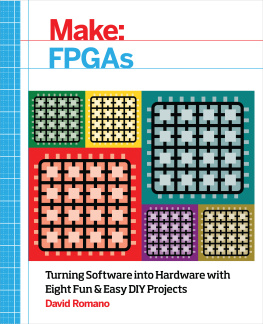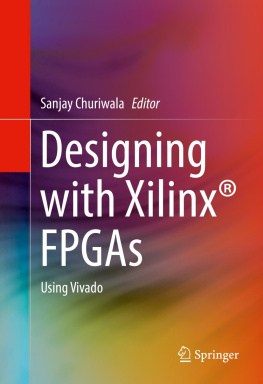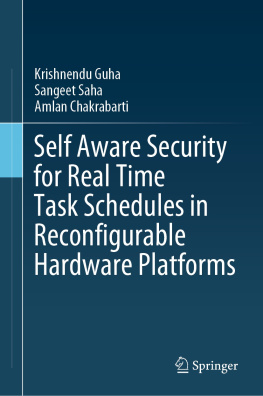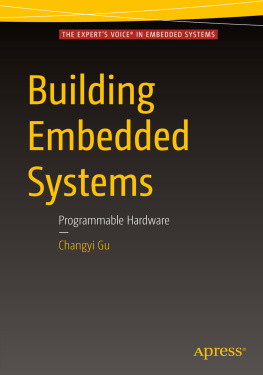Make: FPGAs
by David Romano
Copyright 2016 David Romano. All rights reserved.
Printed in the United States of America.
Published by Maker Media, Inc. , 1160 Battery Street East, Suite 125, San Francisco, CA 94111.
Maker Media books may be purchased for educational, business, or sales promotional use. Online editions are also available for most titles (http://safaribooksonline.com). For more information, contact OReilly Medias institutional sales department: 800-998-9938 or corporate@oreilly.com .
- Editor: Roger Stewart
- Production Editor: Melanie Yarbrough
- Copyeditor: Rachel Head
- Proofreader: Christina Edwards
- Indexer: Judy McConville
- Interior Designer: David Futato
- Cover Designer: Brian Jepson
- Cover Art: Shawn Wallace
- Illustrator: Rebecca Demarest
- February 2016: First Edition
Revision History for the First Edition
- 2016-02-26: First Release
See http://oreilly.com/catalog/errata.csp?isbn=9781457187858 for release details.
Make:, Maker Shed, and Maker Faire are registered trademarks of Maker Media, Inc. The Maker Media logo is a trademark of Maker Media, Inc. Make: FPGAs and related trade dress are trademarks of Maker Media, Inc.
Many of the designations used by manufacturers and sellers to distinguish their products are claimed as trademarks. Where those designations appear in this book, and Maker Media, Inc. was aware of a trademark claim, the designations have been printed in caps or initial caps.
While every precaution has been taken in the preparation of this book, the publisher and author assume no responsibility for errors or omissions, or for damages resulting from the use of the information contained herein.
978-1-457-18785-8
[LSI]
Preface
Mention FPGAs to most people, and they will either give you a blank stare or think you are talking about some kind of golf league. To most of us Makers, the term conjures up thoughts of hardware creativity, exploration, and discovery, but many of you may have written it off as being way too complicated to even consider for your next project. This book is for you! Its all about learning what amazing, easy, and affordable projects you can construct with field programmable gate array (FPGA) technology. We will be doing this with hands-on experiments, in a fun and practical way.
This book is not a university textbook providing in-depth studies on hardware description languages (HDLs), HDL coding techniques, digital logic design theory, or validation methods. There are many very good resources both online and in textbook form that accomplish this goal. This will be more a learn-as-you-go experience. You can think of the book as a road map to a journey of design discovery, and Ill be your guide. But before we jump in, I want to give you a little background on the history of FPGAs.
Most of the technical community was first introduced to this exciting technology back in the 80s. I was a recent college graduate (RCG) with a degree in electrical engineering and had just been hired by a small telecommunications company that designed and manufactured modems and TI multiplexers. The company was developing a product that was, at the time, implemented using many 7400 series integrated circuits (ICs) and programmable array logic (PAL) devices. For many of you, this is probably like talking about funny animal paintings on cave walls. It wasnt the Stone Age of electronic design, but 7400 ICs and PALs are primitive compared to todays state-of-the-art systems-on-a-chip (SoCs). My new manager came to me one day with a data book in hand that he had just received from a company called Xilinx. He dropped the book on my desk and said, Well, since youre the college kid, I want you to convert all of this logic design to an FPGA device, pointing to a large and very complex circuit board. Being a little naive and always eager to work on the latest cutting-edge technology, I said, No problem, should be a piece of cake. It wasnt a piece of cake, but it was my introduction into the incredible world of field programmable array logicsort of a baptism by fire.
A lot has happened in the past three decades in the world of digital design, and programmable logic devices (PLDs) are a big part of it. A PLD is an electronic component used to build reconfigurable digital circuits. Unlike logic gates, like those in the 7400 series ICs, which have fixed logic functions, a PLD has an undefined function at the time of manufacture. Before the PLD can be used in a circuit, it must be programmed (i.e., reconfigured). Before PLDs were invented, read-only memory (ROM) chips were used to create arbitrary combinational logic functionstalk about the Stone Age!
Today, there are many reasons a design team will consider FPGA technology in industry. For example, in many silicon IC design companies, FPGA-based platforms are used for what is called shift left, where a new SoC device is mapped to FPGAs early in the design phase, in order to begin software integration long before the actual silicon device is manufactured. This is called emulation of the design. The big advantage here is that emulation runs orders of magnitude faster than simulation, so you can get some real-world hardware/software interactions very early in the validation phase (mostly on a functional level). The FPGA system typically operates at only a fraction of the silicon operating frequency, but the time saved in integration is tremendous.
Another example of where FPGAs are considered a viable solution in industry is where the design requires having multiple hardware personalities in the same footprint. For example, this was the case for a portable test and measurement instrument that I architected when I was a design engineer. By using an FPGA in the design, the customer was able to download different test instruments to the same hardware, essentially having multiple instruments in one hardware device.
The real question, then, for this book is: why would you, the do-it-yourself hobbyist or student, even consider experimenting with FPGAs? For students, it exposes you to contemporary digital logic design methods and practices in a fun, practical, affordable way. For the hobbyist, my goal is to show you how an affordable, off-the-shelf FPGA platform can be used in some very interesting and fun DIY projects. Many of you have had experience with Arduino or similar small microcontroller projects. With these types of projects, you usually breadboard up a small circuit, connect it to your Arduino, and write some code in the C programming language (which Arduino is based on) to perform the task at hand. Typically your breadboard can hold at best a few discrete components and one or two small ICs. Then you always need to go through the pain of wiring up the circuit and connecting it to your Arduino with a rats nest of jumper wires. Instead, imagine having a breadboard the size of a basketball court or football field to play with and, best of all, no jumper wires. Imagine you can connect everything virtually. You dont even need to buy a separate microcontroller board; you can just drop different processors into your design as you choose. Now thats what Im talking about! Welcome to the world of FPGAs.
FPGA History
Xilinx Inc. was founded in 1984, and as the result of numerous patents and technology breakthroughs, the company produced the first family of general-purpose, user-programmable logic devices based on an array architecture. It called this technology breakthrough the Logic Cell Array (LCA), and with this the Xilinx XC 2000 family of FPGAs was born.
You can think of an LCA as being made up of three types of configurable elements: input/output (I/O) blocks, logic blocks, and an interconnect matrix (see ). From these, a designer can define individual I/O blocks that interface to external circuitry. You can think of these as configurable pins of ports. The designer can also use logic blocks, connected together through the interconnect matrix, to implement logic functions. These functions can be as simple as a counter or as complex as a microcontroller core. In a way the interconnect matrix is like the wires on a breadboard that connect everything together, but completely programmable.







